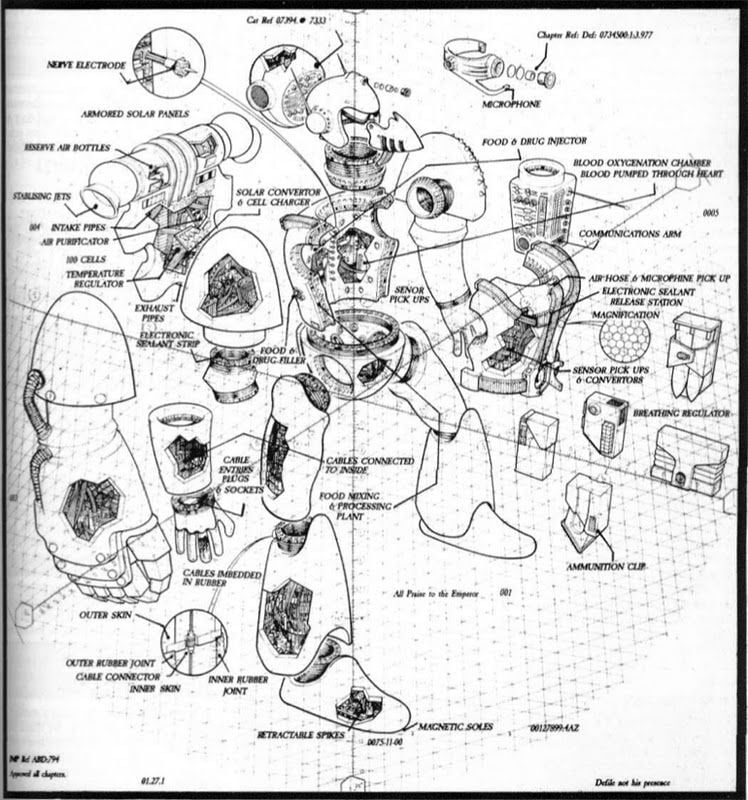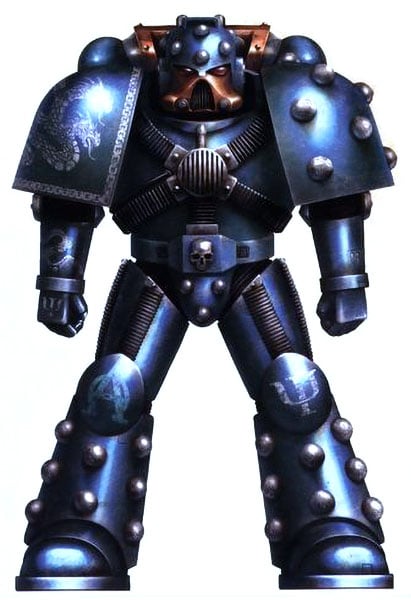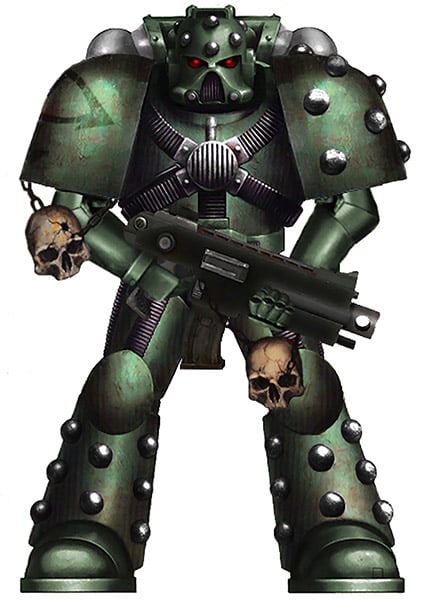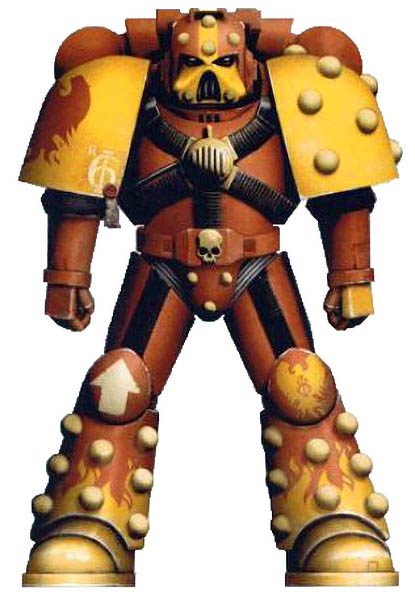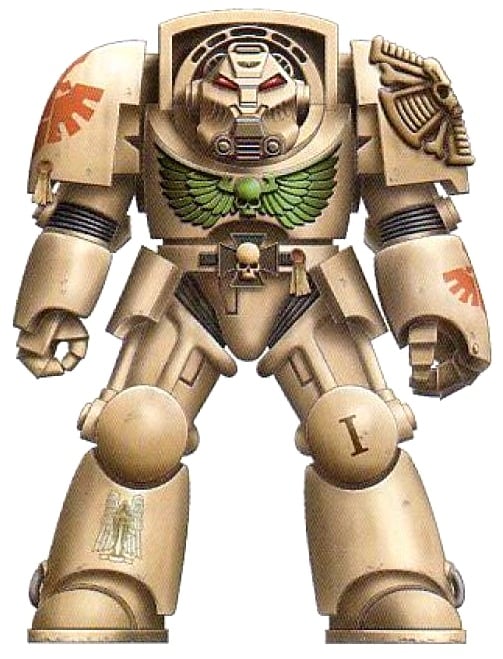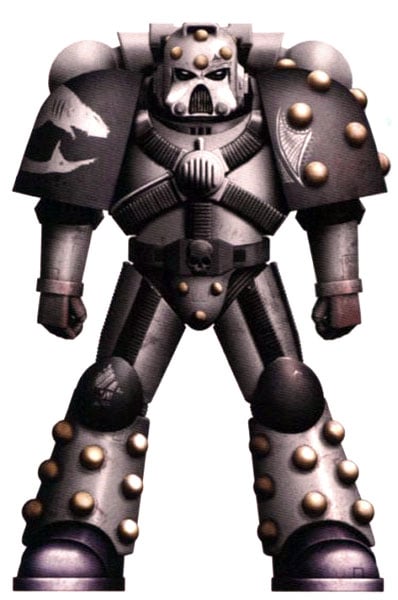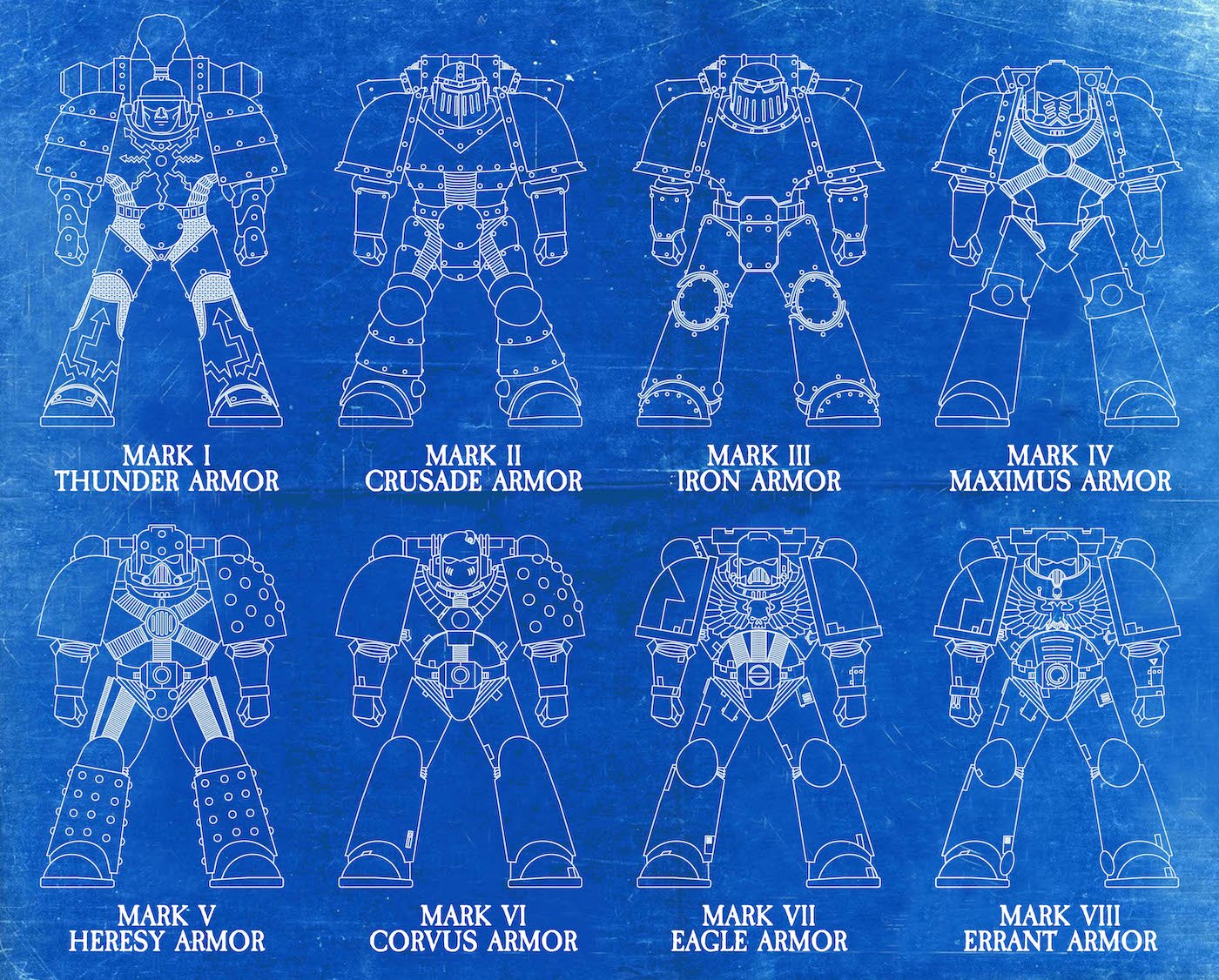Warhammer 40K: Putting The Heresy In Mk. 5 Heresy Armor
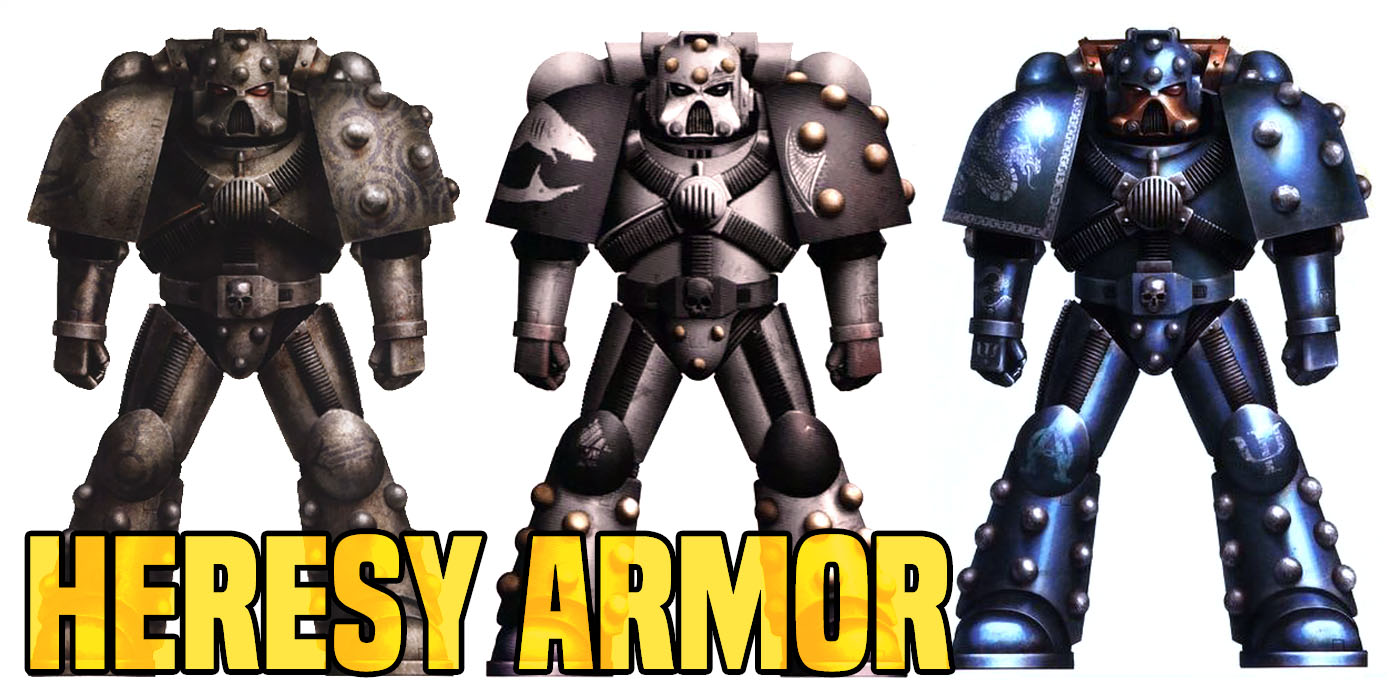

The armor itself isn’t heretical, but if you see someone on the battlefield wearing Mk. 5 Power Armor, it’s never a good sign. Here’s why.
The ill-omened Mk. V Crusade Armor is called “heresy armor,” not because there’s any sort of inherent heresy, or in heresy, in its design, but rather because it was the model of armor most common in use at the time of Horus’ Heresy. With its signature molecular bonding studs, the armor mods bear a bittersweet irony considering how many bonds were broken while wearing it. Let’s learn about Mk. 5 “Heresy Armor.”
Power Armor Overview
Power armor is fully sealed, isolating the wearer from the outside environment and protecting him from gas weapons and harsh atmospheres. It also commonly includes numerous auxiliary systems such as communicators and auto-senses. The backpack contains the main power plant, environmental system, and additional stabilizers.
Whilst power armor is most commonly associated with the Adeptus Astartes, the Sisters of Battle and many Inquisitors also use powered armor of one sort or another. Typically, however, these armors may not contain the same strength-enhancing properties or life-support functions of Space Marine power armor, nor do they provide the same amount of protection. All armor may further be augmented by various artifacts, relics, and enhancements such as pauldrons and greaves.
Power armor has been in use since before the Age of the Imperium, from the techno-barbarians of Earth to the original Space Marines created by the Emperor. Over the history of the Imperium, power armor has developed into many different forms. Need, circumstances, and recovery of new materials and technology have shaped the armor’s evolution.
Space Marine Power Armor
Space Marine Power Armor is an extraordinarily sophisticated defensive system that combines huge resistance to physical damage with a sensory array and sealed environment that protects its wearer from the ravages of the void and alien atmospheres. Integrated with the armor are networks of electro-motivated fiber bundles that mimic and augment the muscular strength of the wearer.
The true genius of the design, however, lies in its close integration with the already superhuman physiology, senses, and reflexes of the Space Marine within. Working in concert, armor and Astartes together become a weapon without equal.
Each suit of Space Marine Power Armor is a work of supreme artisanship, and although it may be one of many, each is a unique artifact whose spirit and history are of deep spiritual significance to both the Chapter to which it belongs and the Space Marine who wears it. It can take decades to complete just one of the new Mk VII power armor, so it is often easier to make a spare part for an existing suit than a completely new one.
There are numerous different Marks of Power Armor, most of which date back in terms of design and application many thousands of years ago to the time of the Great Crusade and the Horus Heresy. Each has its own lore and genesis in place and time. Even in the 41st Millennium, some intact suits from this near-mythical age survive in active service as war relics of the Space Marines.
Countless others have been produced or reacquired since, and different Chapters often have entirely different panoplies they can call upon to armor their forces. It is also far from uncommon for more recently fashioned armor to incorporate slivers or whole components from far older suits as revered connections to the past.
Space Marines undergo an arduous process of receiving various implants, culminating in the implantation of the Black Carapace. This allows the Marine a direct and instinctual interface with the armor, making it, in effect, a second skin. The advanced systems of Space Marine power armor also monitor the Marine’s biological functions, feeding the Marine medical information.
Components
While Space Marine Armor has evolved and changed over the Millennia, key components remain the same.
- Auto-senses: Contained in the helmet, these systems include thought-activated communication arrays and audio filters, targeting reticules and range finders, tactical displays, auspex-links, and a host of other features.
- Photolenses: These protect the Space Marine from light bursts, allow him to see in the infrared and ultraviolet spectrums, and enable vision in low-light conditions.
- Respirator Vox Grill: This thought-activated device amplifies a Marine’s battle cry to deafening volumes and contains a respirator to filter out toxins and draw upon an internal oxygen supply.
- Auto-Responsive Shoulder Plates: Shaped to deflect and absorb incoming blows, they usually display heraldry, including Chapter, Company, and Squad symbols.
- Chestpiece: Designed to protect armored power cables.
- Backpack Power Unit: This houses the primary power core for the armor, reserve cells, and an emergency solar collector.
- Life Signs Monitor: Regulate a suite of life support functions, including an injection system that can regulate painkillers, anti-toxins, and combat stimulants.
- Nutrient Reservoir: A self-replenishing high-energy food store that can sustain a Space Marine’s metabolism. Thus during a battle, there is no need for a Space Marine to eat or drink.
- Reinforced Greaves: These incorporate gyroscopic stabilizers and power units that can magnetize the soles of the armor’s boots, allowing Space Marines to walk on metal surfaces in the void of space or zero gravity environments.
Mark 5 “Heresy Armor”
The equipping of the legions was only partially complete when the Horus Heresy broke out. Many of the Legions that had just been fully equipped with Mark IV armor turned against the Imperium, while many of the loyal Legions had been deliberately starved of access to it and remained operating with the older Mark II and Mark III armor.
Additionally, even the Legions equipped with Mark IV suits quickly found themselves low on spare parts and unable to manufacture replacement units. With war damage and mobile operations, resupply for damaged equipment was difficult or impossible. Marine artificers and Techmarines had to use old-style equipment from older models to keep the legions fighting, as well as salvage from slain enemies and unorthodox innovations of their own.
This ad-hoc assemblage of various armor mark segments (including new or unofficial design elements) being created by a multitude of legions resulted in an entirely new mark of armor being ‘accidentally’ created; these previously non-standard, emergency/stopgap designs were retroactively termed as the Mark V once production of the Mark IV was halted and the design for the subsequent Corvus Armor mark (Mark VI) was finalized.
Some forms of standardization across Mark V suits are notable, despite their apparently random creation and individual varied origins, due to the dissemination of molecular bonding techniques across the legions. These techniques were developed due to battlefield experience in fighting other Astartes; the Astarte’s plate needed to be proof against their own penetrator weapons, and it was discovered that power armor would benefit from additional reinforcing in this regard.
All sorts of improvised additional armor can be seen on Mark V suits, but the most common technique was to affix additional layers of armor with the aforementioned molecular bonding studs. This relatively quick and simple technique effectively added another ablative layer to marine armor suits.
The extra weight this generated would prove considerable, however, which placed a strain on power supplies. As the addition of extra power generation sources and cabling would just require more armor plating, catching the design in an eternal circle, the wearers of the suit were forced to either deal with the additional weight or turn up the power output of his backpack but suffer extreme heat output, which not only would prove uncomfortable and even compromising in certain situations, and in many cases, older, heavy power cabling was used, which created a weak point on the chest
Many Mark V suits ended up featuring an unusual helmet design appropriated from supplies generated by the Tactical Dreadnought Armor program; this spin-off helmet featured similar levels of improved auto-senses as Terminator suits, also called armor, but was still found to be inferior to those of Mark IV suits. The respirator used for this helmet was codified as the Mantilla-pattern and saw use as early as late M30.
The Mark V would be the most common armor mark visible during the Horus Heresy, by its nature as a mark resulting directly from the concerns of that galactic civil war. As a result, the Mark V is commonly called the Heresy Suit and is distinguished by the molecular bonding studs often seen on areas such as helmets, shoulder plates, and greaves.
Few Imperial Space Marines are ever seen in Mark V suits today, as the loyalist Chapters either broke up these suits for spares or purposefully destroyed them after the Heresy was over. In contrast, many Chaos Space Marines still wear Mark V armor by default, either because they still possess their original suits or because they are forced to scavenge equipment.
This power armor carries resonances of the Imperium’s darkest hour and its greatest victory. Battle-Brothers will offer the wearer their respect.
Which mark of power armor is your favorite?

